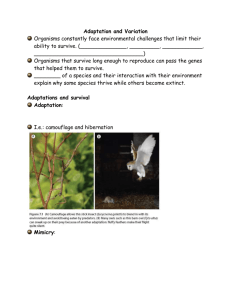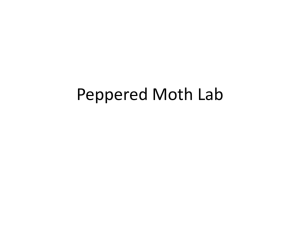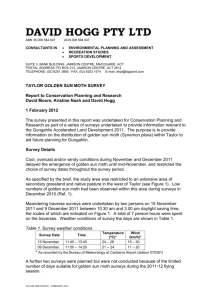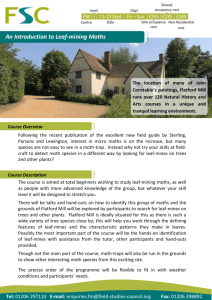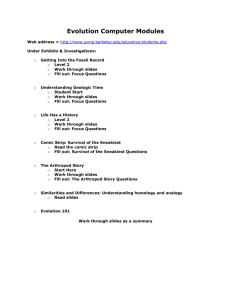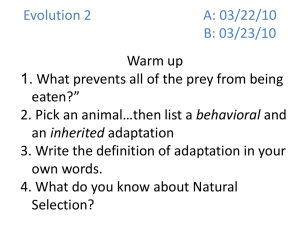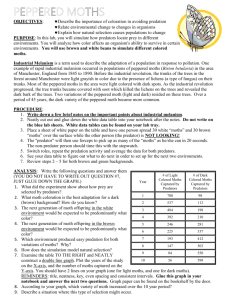1 DAVID HOGG PTY LTD ABN 35 008 564 047 ACN 008 564 047
advertisement
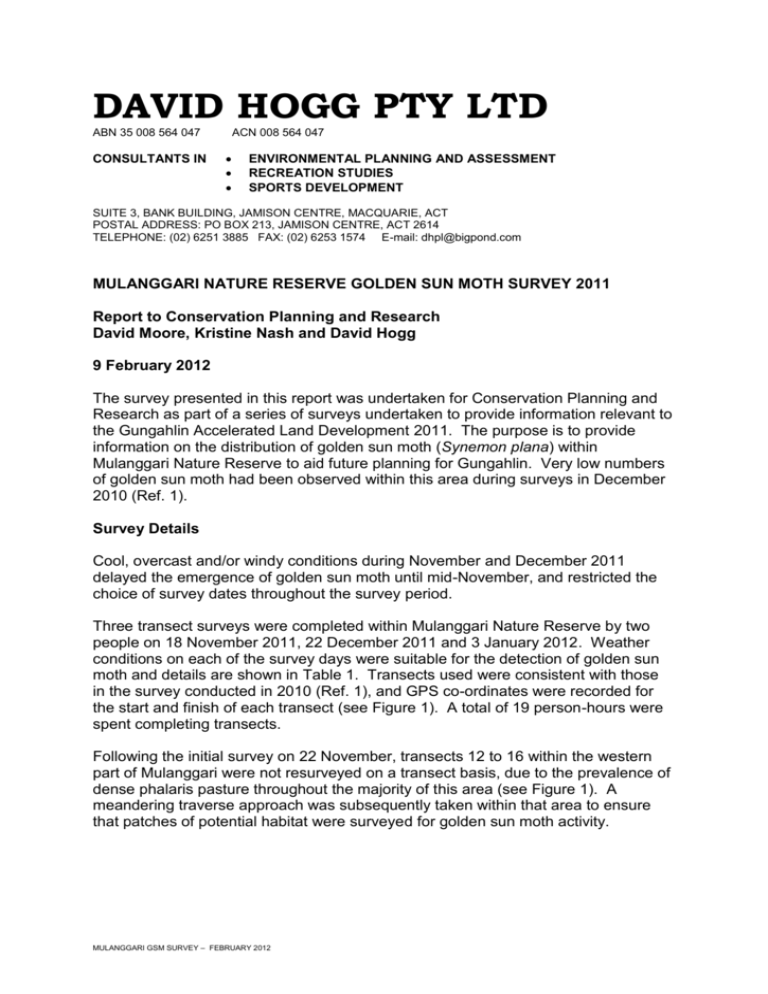
DAVID HOGG PTY LTD ABN 35 008 564 047 CONSULTANTS IN ACN 008 564 047 ENVIRONMENTAL PLANNING AND ASSESSMENT RECREATION STUDIES SPORTS DEVELOPMENT SUITE 3, BANK BUILDING, JAMISON CENTRE, MACQUARIE, ACT POSTAL ADDRESS: PO BOX 213, JAMISON CENTRE, ACT 2614 TELEPHONE: (02) 6251 3885 FAX: (02) 6253 1574 E-mail: dhpl@bigpond.com MULANGGARI NATURE RESERVE GOLDEN SUN MOTH SURVEY 2011 Report to Conservation Planning and Research David Moore, Kristine Nash and David Hogg 9 February 2012 The survey presented in this report was undertaken for Conservation Planning and Research as part of a series of surveys undertaken to provide information relevant to the Gungahlin Accelerated Land Development 2011. The purpose is to provide information on the distribution of golden sun moth (Synemon plana) within Mulanggari Nature Reserve to aid future planning for Gungahlin. Very low numbers of golden sun moth had been observed within this area during surveys in December 2010 (Ref. 1). Survey Details Cool, overcast and/or windy conditions during November and December 2011 delayed the emergence of golden sun moth until mid-November, and restricted the choice of survey dates throughout the survey period. Three transect surveys were completed within Mulanggari Nature Reserve by two people on 18 November 2011, 22 December 2011 and 3 January 2012. Weather conditions on each of the survey days were suitable for the detection of golden sun moth and details are shown in Table 1. Transects used were consistent with those in the survey conducted in 2010 (Ref. 1), and GPS co-ordinates were recorded for the start and finish of each transect (see Figure 1). A total of 19 person-hours were spent completing transects. Following the initial survey on 22 November, transects 12 to 16 within the western part of Mulanggari were not resurveyed on a transect basis, due to the prevalence of dense phalaris pasture throughout the majority of this area (see Figure 1). A meandering traverse approach was subsequently taken within that area to ensure that patches of potential habitat were surveyed for golden sun moth activity. MULANGGARI GSM SURVEY – FEBRUARY 2012 2 Table 1. Survey weather conditions Survey Date Time Temperature (ºC)* Wind (km/h)* 18 November 2011 10:40 – 14:40 22 – 29 9 – 22 22 December 2011 12:15 – 15:00 21 – 24 7 – 15 3 January 2012 10:45 – 13:30 28 – 33 7 - 20 Weather Conditions Warm, mostly sunny with cloud increasing. Light breeze. Mild and mostly sunny with patchy cloud. Occasional light breeze. Hot and sunny with high cloud. Occasional light breeze. * As recorded by the Bureau of Meteorology at Canberra Airport (station 070351) Survey Area Prior to European settlement, the site of Mulanggari Nature Reserve would have supported yellow box – Blakely’s red gum grassy woodland grading into natural temperate grasslands on the lower slopes. Subsequent agricultural practices and tree removal have degraded these ecological communities and, while some remnant woodland trees remain, identification of the transition between these communities is problematic. The current vegetation at Mulanggari Nature Reserve is a mosaic of natural temperate grassland, yellow box – Blakely’s red gum grassy woodland and secondary grassland, degraded native pasture and exotic pasture. Natural temperate grassland persists in low-lying flat areas in the south and south-east, and much of the central and northern areas of the nature reserve may meet criteria for classification as box – gum woodland secondary grassland. For the purposes of the current survey groundcover types within Mulanggari Nature Reserve are classified as predominantly exotic, predominantly native and mixed native and exotic (see Figure 2). Areas of predominantly exotic groundcover are typically dominated by phalaris (Phalaris aquatica), cocksfoot (Dactylis glomerata), tall fescue (Festuca arundinacea) and brome grasses (Bromus spp.) with native species such as tall spear grass (Austrostipa bigeniculata), and wallaby grasses (Austrodanthonia spp.) forming a minor component. Annual and perennial weeds commonly observed were fleabane (Conyza sp.), flatweed (Hypochaeris radicata), capeweed (Arctotheca calendula), plantain (Plantago lanceolata), serrated tussock (Nassella trichotoma) and St John’s wort (Hypericum perforatum). The locally uncommon native forb emu foot (Cullen tenax) was observed on the edge of the site within an area of predominantly phalaris pasture (Coordinates: 0693970 6103125). The species composition within areas of native groundcover varies across the site, with some areas supporting both high and low diversity of native species. Mapping of this variation is not a component of the current brief and detailed flora surveys were not undertaken. Dominant native grasses include both tall spear grass and corkscrew spear grass (Austrostipa scabra), wallaby grasses, and kangaroo grass MULANGGARI GSM SURVEY – FEBRUARY 2012 3 (Themeda australis), which is particularly common on the lower slopes. Other native grasses such as hairy panic (Panicum effusum), wheat grass (Elymus scaber) and snow grass (Poa sp.) are also present. Some diversity of native forbs is present in patches with blue devil (Eryngium ovinum), nodding chocolate lily (Arthropodium fimbriatum), yellow rush lily (Tricoryne elatior), common everlasting (Chrysocephalum apiculatum), common woodruff (Asperula conferta), matrushes (Lomandra spp.), smooth New Holland daisy (Vittadinia muelleri), fuzzy New Holland daisy (Vittadinia cuneata), native bindweed (Convolvulus erubescens), native bluebells (Wahlenbergia spp.) and small St John’s wort (Hypericum gramineum) observed. Exotic grasses and weeds, particularly phalaris, serrated tussock and fleabane, are scattered. Areas of mixed native and exotic groundcover support similar species to the predominantly exotic areas, but with a greater proportion of both tall spear grass and corkscrew spear grass and wallaby grasses. Additional native grasses such as hairy panic, wheat grass and windmill grass (Chloris truncata) are also present, along with common native forbs including native bluebells, small St John’s wort, native bindweed and fuzzy New Holland daisy. Based on recent observations of golden sun moth populations within secondary grassland and degraded native pastures throughout Gungahlin (Ref. 2) golden sun moths have the potential to be present in most areas mapped as supporting mixed or native groundcover. Areas mapped as predominantly native are, however, more likely to represent better quality habitat. Although areas of exotic groundcover are unlikely to support golden sun moth, moths may persist in isolated pockets of native pasture or fly over areas of dense exotic pasture after emerging from nearby sites. Results and Interpretation Transects followed within Mulanggari Nature Reserve are shown in Figure 1. Grid references for transect starting and finishing locations are presented in Table 2. Approximate routes of meandering traverse surveys in western Mulanggari are shown in Figure 1. Locations of golden sun moth observations are shown in Figure 2. The number of moths observed is marked for each 100m of transect, except where no moths were observed. In general, flying moths were associated with areas of short vegetation. A total of 24 moths were observed within Mulanggari Nature Reserve during the survey. 17 moths were observed on 18 November, five moths were observed on 22 December, and 2 moths observed on 3 January. Based on a method of semiquantitative assessment of golden sun moth sites developed by this firm (Ref. 3), two sites were within the low – moderate range of activity (i.e. four to ten moths sighted per 100 metres) and the remaining sites were within the range of low activity (i.e. four or less moths sighted per 100 metres). The distribution of golden sun moth observations shown in Figure 1 indicates a very low level of golden sun moth activity dispersed across the majority of suitable habitat within Mulanggari Nature Reserve. Given the relatively cool flying season, it is uncertain whether the data obtained accurately represents the distribution or MULANGGARI GSM SURVEY – FEBRUARY 2012 4 abundance of the moths within Mulanggari. Moths were observed over a considerably larger area than during the 2010 surveys (Ref. 1), when seasonal conditions were also poor for the detection of golden sun moth. Golden sun moths were not observed in the same locations as in 2010. This indicates that the results to date are unlikely to represent the full extent of the golden sun moth distribution within Mulanggari Nature Reserve. Table 2. Transect coordinates Transect 1 2 3 4 5 6 7 8 9 10 11 12 13 14 15 16 0695126 0695037 0694948 0694865 0694762 0964670 0694567 0694426 0694339 0694260 0694184 0694092 0693997 0693896 0693725 0693723 North 6103682 6103719 6103755 6103799 6103816 6103826 6103851 6103883 6103851 6103937 6103976 6103997 6104017 6104042 6103517 6104061 0695031 0694951 0694845 0964699 0694623 0694531 0694406 0694284 0694183 0694110 0694041 0963975 0693883 0693778 0693820 0693635 South 6103007 6102988 6102961 6102926 6102920 6102921 6102782 6102499 6102513 6102825 6102975 6103109 6103278 6103443 6104050 6103642 Conclusions The surveys confirm that golden sun moths occur in low numbers throughout parts of the reserve, although locations of observations were not consistent with those from the previous year. Generally, moths were observed flying only at low numbers elsewhere in Canberra during the 2011 flying season. This makes it difficult to quantify the distribution or abundance of the golden sun moth population within Mulanggari Nature Reserve or to assess reliably the relative value of the reserve as golden sun moth habitat. Because of the low numbers and variable distribution of golden sun moths recorded in the reserve, the value of undertaking further transect surveys is questionable. If further surveys are undertaken, it is recommended that these be based on meandering traverses concentrated in the areas of predominantly native vegetation, at least until sufficiently high moth counts are recorded to justify a meaningful quantitative assessment based on transects. References 1. Moore, D, McIntosh, J, Nash, K, and Hogg, D.McC. Mulanggari Nature Reserve golden sun moth survey. Report to Conservation Planning and Research by David Hogg Pty Ltd, January 2011. MULANGGARI GSM SURVEY – FEBRUARY 2012 5 2. Hogg, D.McC. A strategic approach to the conservation and environmental assessment of golden sun moth sites in the Canberra area. Interim revised report. Prepared by David Hogg Pty Ltd on behalf of Land Development Agency, December 2010. 3. Hogg, D.McC. Semi-quantitative assessment of golden sun moth sites. Report by David Hogg Pty Ltd. Appendix B to Ref. 3. MULANGGARI GSM SURVEY – FEBRUARY 2012

